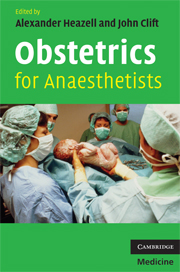Book contents
- Frontmatter
- Contents
- List of contributors
- Foreword
- Preface
- Acknowledgements
- List of abbreviations
- 1 Maternal physiology and obstetrics
- 2 Antenatal care
- 3 Induction of labour
- 4 Normal labour
- 5 Abnormal labour
- 6 Fetal monitoring
- 7 Pre-eclampsia and hypertensive disorders of pregnancy
- 8 Operative obstetrics
- 9 Obstetric haemorrhage
- 10 Thromboembolic disorders of pregnancy
- 11 Infection
- 12 Life support in obstetrics
- 13 Drugs in obstetrics
- 14 Confidential enquiries into fetal, neonatal and maternal death
- Appendix 1 Adult Advanced Life Support Algorithm
- Appendix 2 The Management of Postpartum Haemorrhage Algorithm
- Appendix 3 Emergency Management of Eclamptic Fit Algorithm
- Index
- References
4 - Normal labour
Published online by Cambridge University Press: 21 August 2009
- Frontmatter
- Contents
- List of contributors
- Foreword
- Preface
- Acknowledgements
- List of abbreviations
- 1 Maternal physiology and obstetrics
- 2 Antenatal care
- 3 Induction of labour
- 4 Normal labour
- 5 Abnormal labour
- 6 Fetal monitoring
- 7 Pre-eclampsia and hypertensive disorders of pregnancy
- 8 Operative obstetrics
- 9 Obstetric haemorrhage
- 10 Thromboembolic disorders of pregnancy
- 11 Infection
- 12 Life support in obstetrics
- 13 Drugs in obstetrics
- 14 Confidential enquiries into fetal, neonatal and maternal death
- Appendix 1 Adult Advanced Life Support Algorithm
- Appendix 2 The Management of Postpartum Haemorrhage Algorithm
- Appendix 3 Emergency Management of Eclamptic Fit Algorithm
- Index
- References
Summary
Introduction
Labour is a physiological process and as such there are times when it may work efficiently and times when it may be dysfunctional. By monitoring the process of labour we aim to detect deviations from normality, and intervene appropriately. Whilst appropriate interventions, at the appropriate time, promote maternal and fetal wellbeing, inappropriate, unnecessary or badly timed interventions may compromise it.
Throughout this chapter a distinction will be drawn between nulliparous and multiparous women. Multiparous women have a more compliant cervix and faster progress in labour can be anticipated.
Definition of labour – stages of labour
There is no standard definition of labour. However most suggested definitions incorporate progressive effacement and dilatation of the cervix in the presence of regular painful uterine contractions.
Labour can be divided into three stages:
First stage – Onset of labour until full dilatation of the cervix (10 cm)
Second stage – Full dilatation of the cervix until delivery of the baby
Third stage – Delivery of the baby until delivery of the placenta
First stage of labour
The first stage can be further divided into the latent phase (early labour) and active phase (established labour) (Figure 4.1).
During the latent phase the cervix is changing (softening and effacing) but often shows little change in dilatation. In primiparous women the cervix usually becomes completely effaced before dilating, whereas in multiparous women the cervix may begin to dilate before effacement is complete.
Keywords
- Type
- Chapter
- Information
- Obstetrics for Anaesthetists , pp. 31 - 39Publisher: Cambridge University PressPrint publication year: 2008



